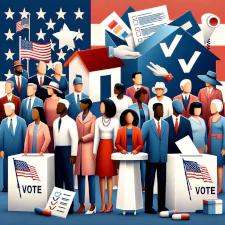The 1970 Voting Rights Act Amendments brought crucial changes to American democracy, spotlighting a harrowing irony: while thousands of 18-year-olds were dying in wars, they were denied the right to vote. This legislation lowered the voting age from 21 to 18, acknowledging the sacrifices of young soldiers in Vietnam, World War II, and Korea. It was a bold move to empower the very youth who were fighting and dying for the country, reshaping the political landscape and amplifying their voices in the democratic process.
Key Takeaways
- Expanded Voter Access: The 1970 amendments significantly broadened voter access by lowering the voting age and eliminating literacy tests, enfranchising millions more Americans.
- Legal and Political Impact: These changes had profound legal and political impacts, reshaping the electorate and prompting subsequent legal clarifications and adjustments.
- Youth Empowerment: By lowering the voting age, the amendments recognized and empowered younger citizens, aligning voting rights with military service eligibility and increasing youth political engagement.
Table of Contents
- Understanding the 1970 Changes to the Voting Rights Act
- The Importance of the 1970 Voting Amendments
- Lowering the Voting Age: From 21 to 18
- The Benefits of the 1970 Voting Rights Amendments
- Controversies and Challenges Surrounding the Voting Rights Act Amendments in 1970
- Later Revisions and Extensions of the Act
- Unleashing the Power of Youth:
- Dismantling Discrimination: The 1970 Voting Act
- Why the 1970 Voting Amendments Matter Today
- Fun Facts & Rarely Known Small Details about the Act
- Voting Rights Act Amendments of 1970
- Frequently Asked Questions:
Understanding the 1970 Changes to the Voting Rights Act
In a nutshell, it was a groundbreaking piece of legislation that aimed to make voting easier and more inclusive for all American citizens. It did this through two primary means:
- Lowering the voting age from 21 to 18
- Banning literacy tests
Which had been used as obstacles preventing racial minorities from voting.
This was democracy at its finest hour – ensuring that every individual, regardless of their age or educational background had an unencumbered right to cast their vote.
The Importance of the 1970 Voting Amendments
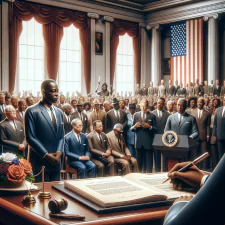
So why drop anchor in 1970? Well, these amendments didn’t just sprout up out of nowhere. The United States was witnessing significant changes during this period. An escalating Vietnam War overseas stirred domestic unrest and calls for peace back home.
The burgeoning Civil Rights movements challenged systemic racism, and youth activists demanded a say in governmental decisions that directly affected them.
Amidst this turbulent backdrop, many Americans felt excluded from participating in their democracy due to archaic laws and policies. The push for political inclusivity reached a crescendo resulting in these timely amendments in 1970.
The objective was crystal clear – reshape America’s electoral landscape by making it more representative and inclusive. And thus began another chapter in America’s ceaseless pursuit towards perfecting its democracy.
Lowering the Voting Age: From 21 to 18
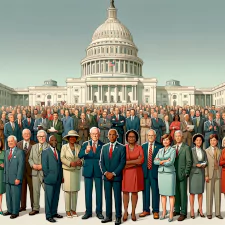
The winds of change were blowing hard in 1970, and one notable provision that these gusts brought in was a reduction in the voting age. Previously, a citizen needed to be at least 21 years old to participate in national elections.
A direct response to an increasingly vocal youth movement, irked by their eligibility for military draft but not for voting, put forth an argument that resonated loudly
— “Old enough to fight, old enough to vote.”
Thus came about the amendment reducing the age of enfranchisement from 21 to 18.
This shift was not just about numbers; it represented a sea change in political empowerment. The lowering of the voting age acknowledged youth as critical stakeholders in democratic processes.
It gave voice and vote to millions who had previously been left out – students, young workers, soldiers. It fundamentally altered who could influence and shape electoral outcomes.
Voting Rights Act Amendments of 1970 No More Literacy Tests:
The Voting Rights Act Amendments of 1970 also declared literacy tests illegal nationwide for five years—a monumental move against clandestine methods some states used primarily as barriers against African-American voters. Until then literacy tests were used ostensibly as tools for assessing a citizen’s capability to understand electoral issues but effectively served as potent tools of discrimination.
Elimination of these tests did more than just strike out words on paper—it knocked down walls that had long kept substantial swathes of the population away from exercising their constitutional right. It represented a significant stride towards leveling America’s electoral playing field by ensuring that every voice—regardless of education level—had equal weight.
Minority Language Protections:
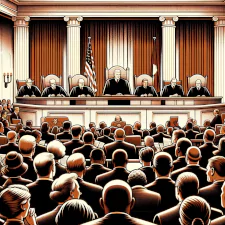
In a determination to accommodate the rapidly diversifying American demographic, the 1970 amendments also included groundbreaking language minority protections. They required that voting materials be provided in languages other than English in jurisdictions where more than five percent of citizens were members of a single-language minority community.
This provision was a harbinger of inclusivity—it was the lawmakers’ way of saying “we hear you” to millions of non-English speaking residents who had thus far been denied their full voting rights due to linguistic barriers. It acknowledged linguistic diversity as an inherent strength, not a drawback, and went miles in making democracy more vibrant and reflective of America’s multicultural fabric.
The Benefits of the 1970 Voting Rights Amendments
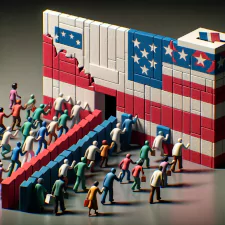
Casting our gaze over the broader panorama, it becomes abundantly clear that the Voting Rights Act Amendments of 1970 were pivotal in extending the reach of American democracy. By lowering the voting age from 21 to 18, it enfranchised a whole new demographic – America’s youth – catalyzing significant strides towards increased voter participation.
With these amendments, nearly 11 million potential young voters were added to the electorate overnight. This newfound political clout offered by these amendments triggered a domino effect leading to spiked levels of civic consciousness and engagement among young people.
Before this amendment, those who fought and died for their country in foreign lands were paradoxically denied their voice at home due to age restrictions.
But with this change, even those serving in far-off Vietnam could now make their voices heard back on American soil.
Key Provisions of the 1970 Voting Rights Act Amendments
The ripple effects of these changes were not merely confined to expanded voter participation but pervaded through to usher seismic shifts in American politics too. The inclusion of fresh demographics within the voting populace brought forth new voices and perspectives that shaped policy-making and electoral outcomes. The youth vote is often credited with assisting Richard Nixon’s narrow victory over Hubert Humphrey in 1972; illustrating how these ‘new’ voters could sway a presidential race.
Moreover, eliminating literacy tests and offering language assistance empowered ethnolinguistic minorities like Hispanics or Native Americans who could now actively participate without language constraints causing disenfranchisement. This encouraged more diverse politicians into elected offices as politics began mirroring society’s multicultural fabric more accurately, enriching the democratic dialogue with multilayered voices.
Controversies and Challenges Surrounding the Voting Rights Act Amendments in 1970
A Legal Minefield: Supreme Court Decisions Through the Lens
Ever since its inception, the Voting Rights Act Amendments of 1970 have navigated through a labyrinth of legal hurdles. One of the most significant challenges was its brush with the Supreme Court in Oregon v. Mitchell. In this landmark case, the justices had to grapple with whether Congress had overstepped its boundaries by lowering the voting age to 18 for both federal and state elections.
In a highly divided verdict, they upheld that while Congress does have the power to regulate age requirements for federal elections, it doesn’t possess such authority over state or local ones – an interesting twist that later led to the ratification of the 26th Amendment, making 18 as universally accepted voting age. This case underscored how deeply rooted and contentious these amendments could be within legal frameworks and interpretations.
Public Opinion at Crossroads: Supporters vs Detractors

The Amendments weren’t just wrestling within courtrooms; they also ignited fiery debates among citizens across America. Supporters leaned on principles of democracy and equality.
They saw these amendments – especially the elimination of literacy tests and language provisions – as necessary tools to dismantle systemic barriers against marginalized communities. Detractors, however, raised eyebrows on federal intrusion into states’ rights.
They argued that regulating voting qualifications should remain a prerogative of individual states – a clash echoing back to America’s perennial debate over federalism vs states’ rights. Where some saw expansion of democracy, others viewed encroachment on sovereignty; where some cheered emancipation from discriminatory structures like literacy tests or English-only ballots others feared dilution in vote quality or pandering to specific groups – an illustrative example of how one piece of legislation can stir polarizing perspectives among its populace.
Later Revisions and Extensions of the Act
Adding More Layers – The Unfolding Story Post-1970
In the episodic saga of American voting rights, the 1970 Amendment served as a pivotal chapter. But, like any good story, it didn’t end there. Several noteworthy revisions followed, each adding new layers to this complex legislation.
For instance, the 1975 amendment expanded upon language minority protection provisions in response to emerging data about voter discrimination against Spanish-speaking and other non-English-speaking minorities. Another significant amendment was passed in 1982 which extended Section 5 of the Act for another twenty-five years.
This critical section required jurisdictions with a history of discrimination to obtain federal ‘preclearance’ before changing their election laws or procedures. Moreover, this amendment also eased the burden of proof for demonstrating discriminatory effects under Section 2 – making it easier for plaintiffs to contest discriminatory practices.
Keeping The Voting Rights Act Legislation Alive
Alongside these revisions came a series of extensions that were instrumental in keeping this landmark legislation from expiring into obsolescence. While initially penned as temporary measures – an emergency response to rampant discrimination – these provisions soon proved their necessity in securing and preserving equitable access to democracy’s most fundamental process: voting.
The Act’s initial expiration date was set for five years after its inception; however, our journey through time reveals how Congress repeatedly extended its lifespan – recognizing its vital role in our society’s quest for equal voting rights.
Congress has since renewed these key provisions four times:
- 1970 (extending it till 1975),
- 1975 (lasting until 1982),
- 1982 (till 2007),
- 2006 (when it was extended until the year 2031).
And thus, through every twist and turn, the Act persists, as a beacon of hope in the ongoing pursuit of voting equity.
Unleashing the Power of Youth:
A New Dawn in American Politics
To truly grasp the seismic shift ushered in by the Voting Rights Act Amendments of 1970, it’s crucial to delve into specific instances that cast a spotlight on this transformative legislation. One such standout is the unprecedented power endowed to younger citizens. By lowering the voting age from 21 to 18, an entire generation was given a voice in their nation’s future.
It’s no exaggeration to say this dramatically reshaped subsequent elections. Consider the 1972 presidential race, just two years after these amendments were enacted.
The youthful anti-war sentiment played a decisive role in shaping Democratic nominee George McGovern’s anti-Vietnam War platform. Although McGovern didn’t cinch the presidency, it was crystal clear that America’s youth had become an influential voting bloc.
Capturing Hearts and Ballots
Fast-forward forty-eight years to another momentous election – not for its results, but for illustrating how significantly youth participation has evolved. In the wake of intense social and political upheaval during President Donald Trump’s term, young voters turned out in droves for the 2020 elections, with polls showing them more politically engaged than ever before. They not only voted but led protests, pushed issues into national discourse, and made savvy use of social media platforms like TikTok and Instagram to mobilize their peers.
Dismantling Discrimination: The 1970 Voting Act
Finding Their Voices
As profound as lowering the voting age was empowering language minority communities through tailored provisions under these amendments. For too long, language barriers had been used as a tool of voter suppression within immigrant and Indigenous populations whose first language wasn’t English.
A case study worth noting is that of Chinese Americans in San Francisco. Before the amendments, they faced formidable obstacles due to language and literacy tests.
However with these barriers removed, there was a significant upswing in Chinese American voter participation. This change broadened representation and encouraged more diverse candidates to step forward.
A Ripple Effect Across the Nation
The effects were not confined to San Francisco or Chinese Americans alone. The 1975 extension of the Voting Rights Act further strengthened language provisions and expanded their reach nationwide – including Spanish-speaking communities in Texas, Asian-Americans in New York, and Native Americans in Alaska. These changes positioned America as a nation embracing its linguistic diversity while ensuring that democratic participation wasn’t exclusive to English speakers alone.
The result? A richer, more diverse political landscape echoing with voices once stifled by systemic bias.
Why the 1970 Voting Amendments Matter Today
A Testament to Tenacity: The Long-lasting Effects on American Democracy
The Voting Rights Act Amendments of 1970 have left indelible imprints on the canvas of American democracy. Not only did they extend voting rights to a sizeable chunk of the population who had been previously disenfranchised, but they also lit up the path toward a more inclusive political landscape. The lowering of the voting age, in particular, ushered a wave of youthful vigor into election booths nationwide.
No longer were voices silenced due to their age; instead, they were emboldened and amplified creating ripple effects that molded subsequent political decisions and elections. Moreover, the abolishment of literacy tests coupled with language protections broke down barriers that had marred minority communities for far too long.
This transformed communities from being mere spectators to active participants in shaping America’s future. The reverberations from these seismic shifts persist even today as these measures have been instrumental in ensuring our political system remains reflective and receptive to its diverse populace.
Democracy’s Unfinished Symphony: The Continued Fight for Voting Rights
As we stand at this juncture reflecting upon the strides we’ve made thus far, it becomes increasingly clear that our journey toward a truly equitable democracy is far from over. The fight for voting rights continues unabated as new challenges emerge and old ones resurface wearing modern guises. Issues like voter suppression tactics or stringent voter identification laws loom large today, threatening to undermine progress achieved throughout decades of struggle.
Furthermore, gerrymandering practices continue undermining representation equity within electoral districts making each step forward seem like two steps back at times. Yet amidst these challenges lies our collective resolve mirrored in countless activists, lawmakers, and ordinary citizens who refuse to back down until every voice is heard equally.
As we move forward, the Voting Rights Act Amendments of 1970 serve as a beacon of inspiration reminding us of our capacity to rally against injustice and ensure everyone has a seat at democracy’s table. It’s not merely a distant echo from history, but a living testament that continues to resonate with our pursuit of an all-inclusive democracy.
Fun Facts & Rarely Known Small Details about the Act
Did You Know? Interesting Trivia about the Act
To begin, let’s dive into some fascinating trivia about the Voting Rights Act Amendments of 1970.
One such intriguing fact is that, despite it being a critical piece of legislation crucial to shaping America’s democracy, its passage was not without controversy. In fact, in Oregon v. Mitchell (1970), the Supreme Court ruled that Congress had overstepped its authority by lowering the voting age to 18 for state elections. Albeit it remained acceptable for federal ones.
Now here’s an amusing tidbit: This same provision led to a rather humorous anomaly during the 1972 presidential election when some states allowed 18-year-olds to vote for President, but not for state or local officials. This quirk led to an interesting patchwork of voting rights across America until the ratification of the 26th Amendment later that year which uniformly lowered the voting age nationally.
Hidden Stories – Lesser Known Incidents Related to its Implementation
Peering into lesser-known incidents related to its implementation reveals a tapestry woven with determination and boldness. For instance, consider Ms. Mary Louise Smith Ware — a civil rights activist from Selma whose arrest under segregation laws caught Dr. Martin Luther King Jr.’s attention and triggered a watershed moment in civil rights history: The Selma Marches leading directly towards the passing of the Voting Rights Act. Ever heard of “reverse literacy tests”?
These were used as clever countermeasures in certain communities where white registrars would tend to fail literate black applicants while passing illiterate white applicants on literacy tests! Community leaders turned this nefarious practice against itself by providing potential voters with primers on how these biased tests might be conducted and how best one could prepare for them.
While these anecdotes might seem like small footnotes in the broader narrative of the Voting Rights Act Amendments of 1970, they breathe life into history and paint a vibrant picture of human resilience and innovation in the face of adversity. To study these minutiae is to understand the struggle for equality not just from a macro perspective but at an intimate, personal level.
Voting Rights Act Amendments of 1970
Frequently Asked Questions:
What are the Voting Rights Act Amendments of 1970?
These amendments extended key provisions of the Voting Rights Act of 1965, including banning literacy tests and lowering the voting age from 21 to 18 for federal elections.
Why were the 1970 amendments significant?
They expanded voter protections and accessibility, ensuring that more Americans, particularly younger citizens and those facing literacy barriers, could participate in elections.
How did the 1970 amendments address literacy tests?
The amendments banned the use of literacy tests nationwide for five years, which had been used to disenfranchise minority voters.
What change did the amendments make to the voting age?
The voting age was lowered from 21 to 18 for federal elections, acknowledging the role and rights of younger citizens, especially those eligible for military service.
What legal challenges arose from the 1970 amendments?
The amendments faced legal scrutiny, notably in the Supreme Court case Oregon v. Mitchell, which upheld the federal voting age change but ruled states could set their voting age for state and local elections.
